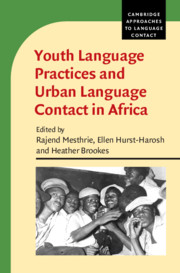Book contents
- Youth Language Practices and Urban Language Contact in Africa
- Cambridge Approaches to Language Contact
- Youth Language Practices and Urban Language Contact in Africa
- Copyright page
- Contents
- Figures
- Tables
- Contributors
- Series Editor’s Foreword
- Preface
- Abbreviations
- Introduction
- 1 Language Contact and Structure in Urban IsiXhosa and Associated Youth Languages
- 2 Not ‘Deep’ but Still IsiXhosa:
- 3 Rethinking Youth Language Practices in South Africa:
- 4 Tsotsitaals, Urban Vernaculars and Contact Linguistics
- 5 Grammatical Hybridity in Camfranglais?
- 6 Sheng and Engsh in Kenya’s Public Spaces and Media
- 7 Exploring Hybridity in Ivorian French and Nouchi
- 8 Authenticity and the Object of Analysis:
- Index
- References
5 - Grammatical Hybridity in Camfranglais?
Published online by Cambridge University Press: 20 August 2021
- Youth Language Practices and Urban Language Contact in Africa
- Cambridge Approaches to Language Contact
- Youth Language Practices and Urban Language Contact in Africa
- Copyright page
- Contents
- Figures
- Tables
- Contributors
- Series Editor’s Foreword
- Preface
- Abbreviations
- Introduction
- 1 Language Contact and Structure in Urban IsiXhosa and Associated Youth Languages
- 2 Not ‘Deep’ but Still IsiXhosa:
- 3 Rethinking Youth Language Practices in South Africa:
- 4 Tsotsitaals, Urban Vernaculars and Contact Linguistics
- 5 Grammatical Hybridity in Camfranglais?
- 6 Sheng and Engsh in Kenya’s Public Spaces and Media
- 7 Exploring Hybridity in Ivorian French and Nouchi
- 8 Authenticity and the Object of Analysis:
- Index
- References
Summary
This chapter discusses some grammatical features of 'African urban youth languages', focusing on Camfranglais in Cameroonian cities such as Yaoundé and Douala. While anti-languages have been characterised as parasitic styles of speaking that graft onto the grammar of another language, developing an ephemeral emblematic lexicon but little or no grammatical structures of their own, Camfranglais stands out in that its grammatical features cannot be entirely reduced to a (Standard) French matrix. Rather, it presents various phonological, morphological and syntactical properties mostly transferred from Cameroonian Pidgin English and its Bantoid substrate languages, most probably via a spectrum of varieties of Cameroonian French. However, as long as the distribution of these features along the continuum Camfranglais–Cameroonian Pidgin English–second-language varieties of French (and English) remains unclear, it cannot be decided whether Camfranglais has indeed developed a hybrid grammar peculiar to itself. On the functional level, Camfranglais retains some typical anti-language characteristics with a tendency to expand as a style of speaking that indexes positive values such as integration, solidarity, progressiveness and a cosmopolitan Cameroonian identity.
Keywords
- Type
- Chapter
- Information
- Youth Language Practices and Urban Language Contact in Africa , pp. 115 - 140Publisher: Cambridge University PressPrint publication year: 2021
References
- 1
- Cited by

